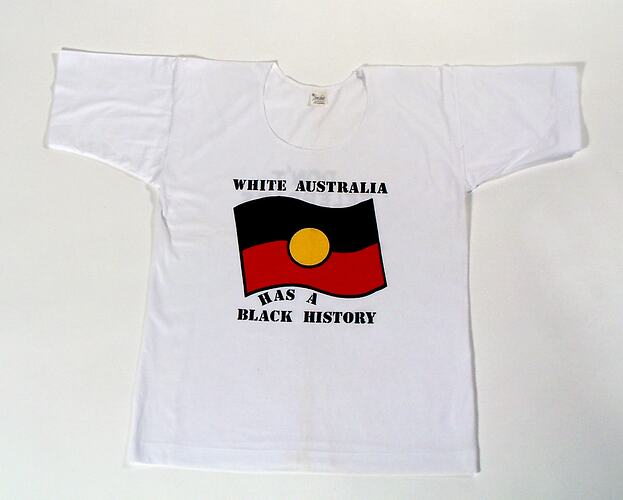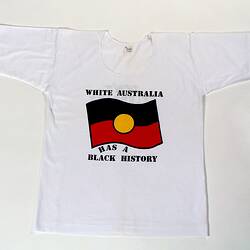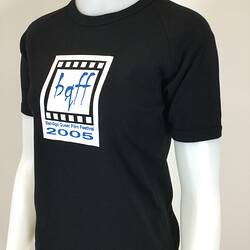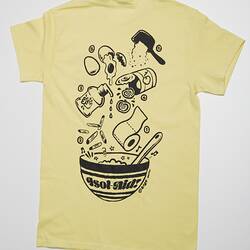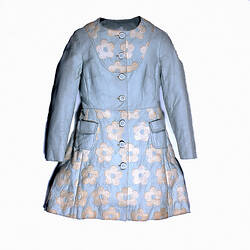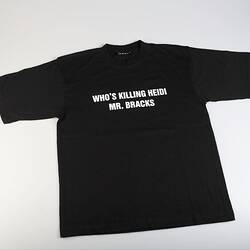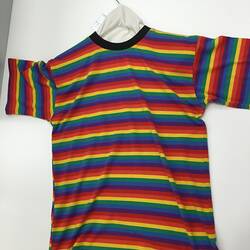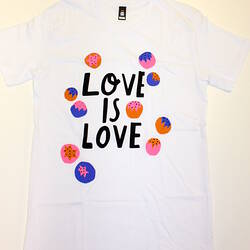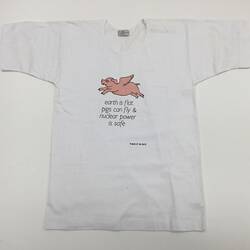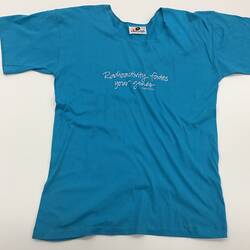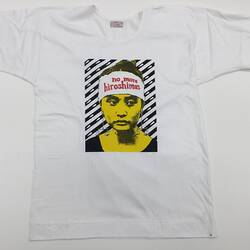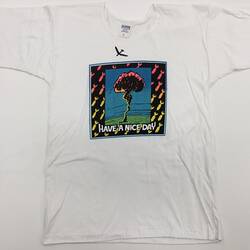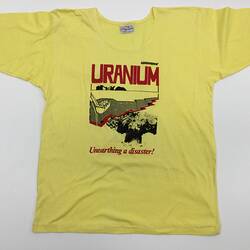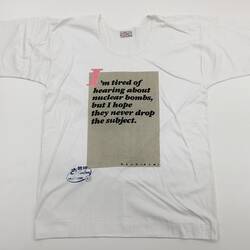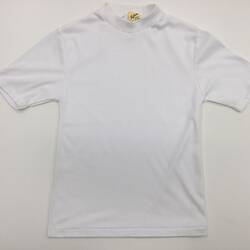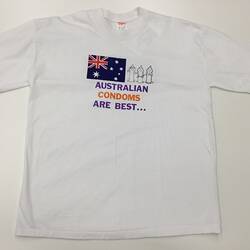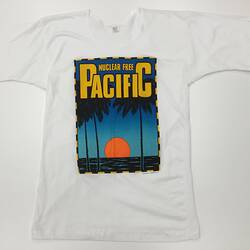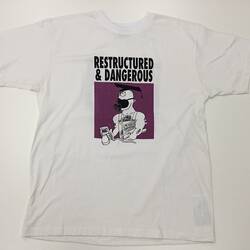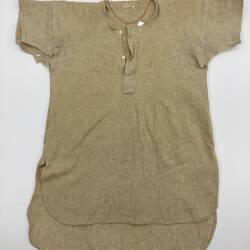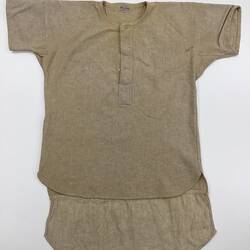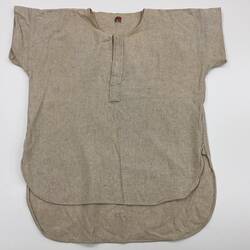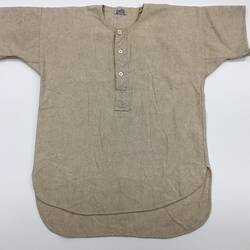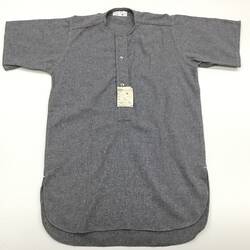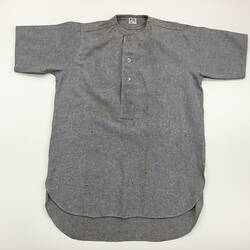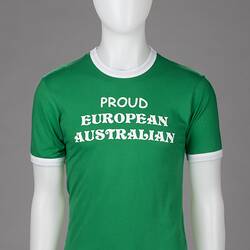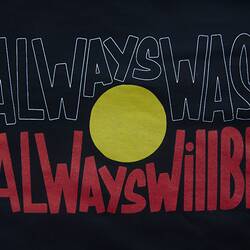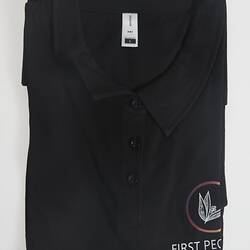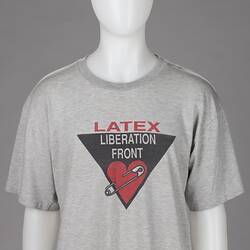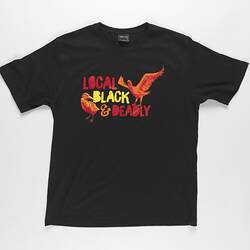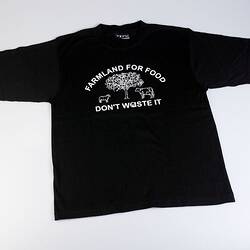Summary
A history of t-shirts and their representation in Museums Victoria's Clothing and Textiles collection.
Museums Victoria has amassed a collection of over 100 t-shirts of various makes and ages, all acquired to tell stories of social, political and working life in Victoria. There are early working men's undergarments, local fashion statement pieces, travel souvenirs, workwear, promotional and protest garments.T-shirts, distinguished by their T-shape and lack of collar, were originally designed as a form of undergarment for men - particularly working men and those in the Armed Services in the late 19th, early 20th century (José, Lee and Vázquez-López, 2019). These early t-shirts, often made from breathable cotton flannel or similar, were practical, affordable, and easily washable. Museums Victoria has only a few examples of these early t-shirts, including a navy drill shirt and some flannel work shirts worn by a miner in Walhalla.
After the end of the Second World War, t-shirts were worn as casual outer wear by ex-servicemen and adopted by young men in the general population (José, Lee and Vázquez-López, 2019). However, all genders and ages were eventually donning the simple t-shirt as fashionable casual wear in a variety of colours and cuts. The t-shirt became a symbol of youth culture, and in the 1960s and 1970s it became a popular form of counterculture and protest (Bekhrad, 2018). Its simple, cheap, and easily adaptable form made the t-shirt an ideal canvas to express one's values. Anti-war, anti-nuclear, pro-environment, and pro-feminist text and images were easily screen-printed to cotton t-shirts. Museums Victoria's earliest protest t-shirts date to the late 1970s, early 1980s. They were purchased for an exhibition in the International Year Of Peace in 1986 and include a number of anti-nuclear messages from community organisations like Friends of the Earth and Movement Against Uranium Mining (MAUM). Slogans like 'No More Hiroshimas', 'Nuclear Free Pacific' and 'Radioactivity Fades Your Genes' reveal a diversity of approaches to the issue of nuclear testing and war. Later social movements represented in the Museums Victoria collection include the Republic Referendum, the Women's March on Melbourne in 2017, refugee rights, and a series of pro- and anti-immigration messages spread in the wake of the 2005 Cronulla riots.
The t-shirt persisted as a work uniform staple in many industries during the 20th century, and it was also an important part of trade union protests and promotions for membership. Museums Victoria has a strong collection of uniform and trade union t-shirts that tell different stories of working life in Victoria, worn by prison workers, barkeepers, painters and decorators, First Peoples health workers, farmers and firefighters among other professions.
In the 1990s and early 2000s the t-shirt became a popular vehicle for brand promotion - not only for corporations but also for community groups and clubs. It was around this time that the t-shirt was also elevated from popular streetwear to high-fashion statement pieces (Tatter, 2022). Museums Victoria holds t-shirts from local designers and boutiques like Tiffany Treloar, Clothing The Gaps and New Model Beauty Queen hanging alongside fundraising shirts for bushfire relief and Covid lockdown music festival Isol-Aid. In the 21st century the t-shirt remains a ubiquitous wardrobe staple for many. Museums Victoria continues to selectively build its t-shirt collection to tell stories of Victorian identity and culture.
References:
Bekhrad, Joobin (2018) 'The T-Shirt: A Rebel With A Cause", BBC Culture, Retrieved January 24 from: https://www.bbc.com/culture/article/20180202-t-shirts-the-worlds-most-expressive-garment
José, F.B. , Lee, H.V. , & Vázquez-López, R.J. (2019). T-Shirt. In H.V. Lee (Ed.). Artifacts from American Fashion. Santa Barbara, California: Greenwood. Retrieved January 31, 2024, from https://www.bloomsburycollections.com/encyclopedia-chapter?docid=b-9798400614774&tocid=b-9798400614774-0002190
'The History of The T-Shirt', Tatter, 27 May 2022, Retrieved January 8 from https://tatter.org/the-history-of-the-t-shirt/
'T-Shirt', Encyclopedia of Clothing and Fashion. Retrieved January 8 from Encyclopedia.com: https://www.encyclopedia.com/fashion/encyclopedias-almanacs-transcripts-and-maps/t-shirt-0
More Information
-
Keywords
-
Authors
-
Article types
